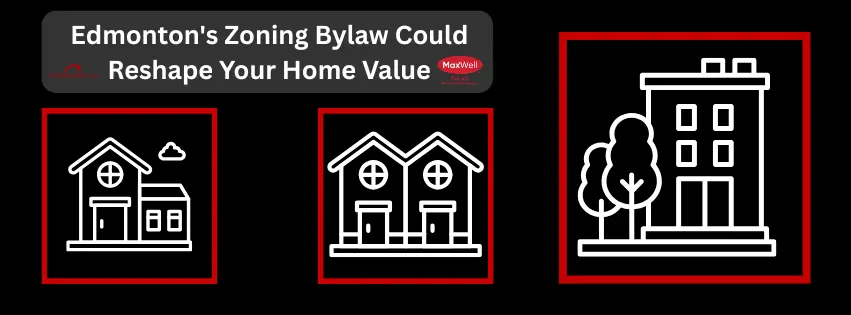Edmonton's Zoning Bylaw Could Reshape Your Home Value
If you own property in Edmonton, changes to the city's zoning bylaw might be affecting your home's value right now. Over a year has passed since the city implemented its new zoning regulations, and the results are starting to show up in real estate numbers.
The bylaw emerged as Edmonton's response to pressing challenges: a housing crisis, unchecked urban sprawl, and a population growing faster than anyone expected. Alberta welcomed 27% of Canada's immigrants last year, and Edmonton needed a way to house them without paving over more farmland or leaving neighborhoods empty.
The solution? Allow duplexes and multiplexes to be built across the city without lengthy rezoning processes. Developers can now get approval faster, and the city has already greenlighted more than half the housing needed to meet its 2026 goals.
But not everyone is celebrating. Some residents worry about parking shortages, blocked sunlight, and buildings that clash with their neighborhood's character. Others are trying to add restrictive covenants to their land titles to prevent multi-unit developments altogether.
Understanding how these changes affect property values requires looking at what's actually happening in different neighborhoods and housing types across the city.
How the Bylaw Changes Housing Density
Before the new zoning rules took effect, 111 of Edmonton's central neighborhoods operated under the Mature Neighbourhood Overlay. This overlay maintained strict regulations on new developments to preserve neighborhood character through rules about building height, setbacks, and exterior design.
These regulations also kept density low, favoring single detached homes.
The removal of this overlay opened the door for more housing variety in areas that already have access to transit, schools, fire stations, and recreational facilities. The city's rationale is straightforward: why build new infrastructure when existing services are underutilized?
Currently, many mature neighborhoods have smaller populations than they were originally built to accommodate. Less than half of Edmonton's residents can afford the benchmark price of a single detached home ($105,000), and average household sizes continue to shrink. Meanwhile, demand for multi-unit dwellings and rentals keeps climbing as immigrants, retirees, and young professionals seek smaller, less expensive housing options.
The city aims for more than half of new housing units to be built in these mature neighborhoods, increasing density around amenities rather than expanding outward.
What September 2025 Market Data Reveals
Real estate statistics from September 2025 show a market responding to these zoning changes in unexpected ways. Overall, the Greater Edmonton Area saw 3,645 new listings hit the market—a 16.3% jump compared to September 2024. Available inventory increased by 25.6% year-over-year, giving buyers more options.
Sales activity cooled, with 2,192 units sold in September. That's a 7.8% decrease from August and a 2.9% dip from the previous year. The average selling price across all residential property types settled at $452,849, down 1.8% from August but still 2.8% higher than September 2024.
Here's where it gets interesting: different property types are behaving very differently under the new zoning rules.
Detached Homes Face Pressure
Detached homes saw prices soften in September, with the average price dropping 2.8% from August to $554,084. Year-over-year, the price was only 0.2% higher than September 2024. New listings for detached homes surged 18.6% compared to the previous year, but sales fell 7.7% month-over-month.
This pattern makes sense. As the zoning bylaw makes it easier to build multi-unit housing, buyers have more affordable options. The premium once commanded by detached homes in mature neighborhoods is being tested.
Semi-Detached Properties Surge
Semi-detached homes tell a completely different story. Average prices rose to $433,760 in September—a 3.1% increase from August and a robust 5.3% jump from September 2024. This happened even as sales decreased by 5.9% month-over-month and 2.4% year-over-year.
Why are semi-detached homes gaining value? They offer a middle ground. Buyers get some of the benefits of a detached home—more space, outdoor areas, less shared walls than townhomes—at a lower price point. Under the new zoning rules, these properties fit naturally into neighborhoods transitioning to higher density.
Townhomes Show Resilience
Row houses and townhomes also bucked the downward price trend. The average price reached $303,382, marking a 0.5% increase from August and a 3.4% rise from September 2024. New listings jumped 30.4% compared to the previous year, yet prices held steady despite the increased supply.
This segment attracts first-time buyers, downsizing retirees, and new immigrants—all groups whose numbers are growing in Edmonton. The zoning changes make it easier to build these units where people actually want to live, near transit and amenities.
Condos Face Headwinds
Apartment condominiums struggled in September. Sales dropped 11.9% from August and 8.7% from the previous year. The average price fell 4.9% in one month to $207,363, though it remained 3.8% higher than September 2024.
The condo market's challenges may reflect oversupply in certain areas or competition from newly available townhomes and semi-detached options at not-much-higher price points.
The Pushback From Residents
Not everyone welcomes these changes. The most heated debates at recent city council hearings centered on a proposal to reduce the maximum number of units allowed on a lot from eight to six. Residents of affluent neighborhoods like Glenora and Crestwood have voiced concerns about:
- Loss of neighborhood character
- Insufficient parking
- Large buildings blocking natural light
- Unattractive new developments lowering property values
Some residents are exploring restrictive covenants that would prevent multi-unit development on their properties even after selling. This legal tactic has prompted discussions about whether further restrictions are needed.
City councilors debated the issue extensively. Mayor Amarjeet Sohi and others worried that reducing unit maximums wouldn't satisfy opponents, who might continue pushing for additional restrictions. Ultimately, the council rejected the reduction for now but will revisit the issue after further investigation.
The Equity Argument Behind Higher Density
Research conducted by the Alberta Land Institute examined how the previous zoning bylaw supported inequity and made recommendations for the new rules. One key finding focused on distributional equity—the fair distribution of goods and services to the public.
Edmonton's best amenities are most accessible to residents of mature neighborhoods. Before the zoning changes, these areas were characterized by low density and single detached homes. Only residents who could afford higher-priced detached homes could live near transit, schools, and recreational facilities.
By allowing more housing types in these neighborhoods, a larger portion of the population can afford to live near key amenities. This matters especially for vulnerable populations. Low-income individuals, people with disabilities, and immigrants are more likely to rely on transit. Meanwhile, higher-income individuals who can afford detached homes in the core are far less likely to use the readily available transit.
The new zoning attempts to correct this imbalance by making it possible for people across income levels to live in well-serviced areas.
What Comes Next for Property Values
The upcoming municipal election could shift Edmonton's housing policy. Tim Cartmell, a city councilor running for mayor, has proposed revisiting parts of the bylaw and re-engaging with citizens. His platform includes placing some restrictions on infill development.
Another mayoral candidate, Andrew Knack, has expressed concern about limiting new housing construction. "We are a rapidly-growing city—200,000 people in the last four years have moved into Edmonton," Knack said. "If we aren't building in our older neighborhoods, where is everyone going to live?"
For homeowners wondering about property values, the data suggests different trajectories depending on property type and location:
Detached homes in mature neighborhoods may face continued pressure as buyers find alternatives. However, well-maintained homes on desirable lots should retain value, especially if restrictive covenants limit nearby development.
Semi-detached homes and townhomes appear positioned to benefit from the zoning changes. These property types offer affordability while still providing more space than apartments. Demand seems strong enough to support price growth even as supply increases.
Condos face the most uncertainty. Price stability will likely depend on location and building quality. Units near transit and amenities should fare better than those in areas without these advantages.
Future development potential adds a new wrinkle. Properties in mature neighborhoods that could be redeveloped into duplexes or small multiplexes might command a premium from developers, even if current home values soften.
Navigating Edmonton's Evolving Market
Edmonton Real Estate has maintained relatively affordable housing compared to other Canadian cities, partly because of these zoning changes. The sped-up permitting process helps developers gain approval faster, which increases supply and helps control prices.
The city faces a balancing act between meeting housing needs for a growing population and addressing concerns from residents who fear losing neighborhood character. Whatever happens in the fall election, Edmonton's next mayor and council will continue wrestling with how to prioritize the needs of current and future residents.
For property owners, staying informed about zoning discussions and market trends will be essential. The changes unfolding now will shape Edmonton's housing landscape for years to come, with different effects on different property types and neighborhoods.
Real estate patterns from September 2025 suggest the market is adjusting to new realities. While some segments cool, others heat up. Understanding these shifts can help homeowners and buyers make better decisions about when to sell, what to buy, and where to invest in Edmonton's evolving housing market.
Posted by Admin . on


Leave A Comment